Cat × Chicken
Mammalian Hybrids
|
This would have been the right kind of cat for me to keep if I had kept any; for why should not a poet’s cat be winged as well as his horse?
—Henry David Thoreau, Walden
|
Video: Three cats with wings.
Video: A cat with wings.
Claims that hybrids can be produced from this highly disparate cross require confirmation from a testable specimen.
The two videos at right document that winged cats exist (in addition, many reports about winged cats are quoted at the bottom of this page). More than a hundred cases of winged cats have been reported. So in the following discussion it is taken for granted that winged cats do in fact exist. The only question considered is where do they come from? Are they mutants? Are they bird-mammal hybrids? Or are they perhaps suffering from a skin disease or a lack of grooming, as some suggest?
Matted hair? Would any sort of disease, or any grooming deficiency, cause many different cats (there are more than a hundred separate cases of winged cats reported) to sprout paired symmetrical growths in the expected position for wings? And what of the various reports that say these wings contain bones and muscle? Could disease or poor grooming produce bones and muscle tissue? The cats in the various videos and photographs do not look diseased or ill-groomed.
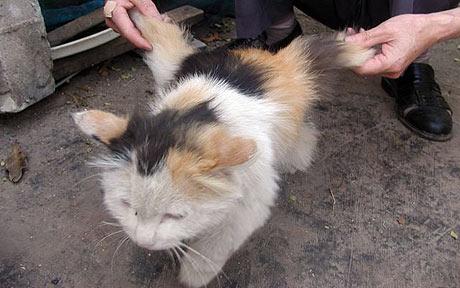 A winged cat caused a sensation in China’s Sichuan province in 2008. According to news stories, its wings contained bone.
A winged cat caused a sensation in China’s Sichuan province in 2008. According to news stories, its wings contained bone.
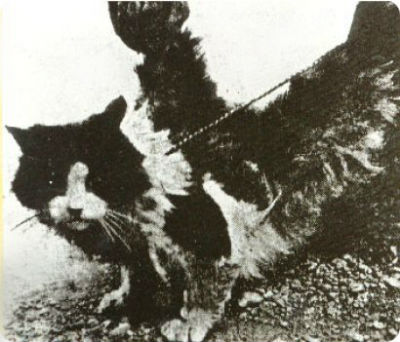 The Oxford winged cat (see report below). This cat, which allegedly flew, must have had a wingspan in excess of two feet, given that its wings look longer than those of the other winged-cats pictured below, which did have wingspans of two feet.
The Oxford winged cat (see report below). This cat, which allegedly flew, must have had a wingspan in excess of two feet, given that its wings look longer than those of the other winged-cats pictured below, which did have wingspans of two feet.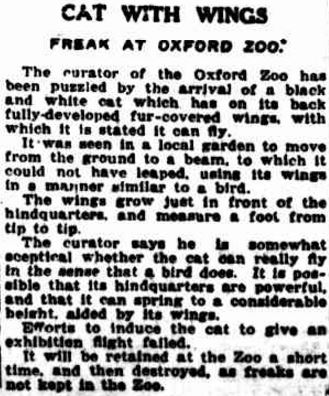
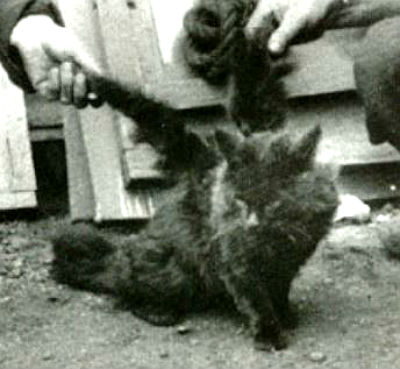 Above: A winged cat that lived at Banister Walton & Co. builder’s yard at Trafford Park, Manchester, England, during the 1960s. It had a wingspan of two feet. Workmen said the cat could raise its wings above its body, which shows that they contained muscle.
Above: A winged cat that lived at Banister Walton & Co. builder’s yard at Trafford Park, Manchester, England, during the 1960s. It had a wingspan of two feet. Workmen said the cat could raise its wings above its body, which shows that they contained muscle.
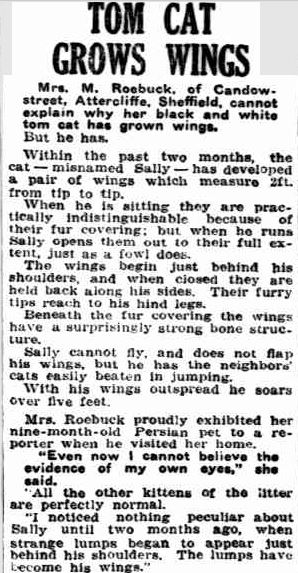 Above: A news story about a winged cat in England. Source: The Mirror (Aug. 29, 1939, p. 10), a newspaper published in Perth, WA.
Above: A news story about a winged cat in England. Source: The Mirror (Aug. 29, 1939, p. 10), a newspaper published in Perth, WA.
 Above: A news story about a winged cat shot in Sweden in 1949. The remains were given to the Swedish Museum of Natural History. Source: The Glen Innes Examiner (Jun. 15, 1949, p. 2), an Australian (NSW) newspaper.
Above: A news story about a winged cat shot in Sweden in 1949. The remains were given to the Swedish Museum of Natural History. Source: The Glen Innes Examiner (Jun. 15, 1949, p. 2), an Australian (NSW) newspaper.
Supernumerary limbs? The possibility that these appendages are supernumerary limbs has been suggested, but such limbs are ordinarily leglike and do not grow in symmetric pairs. Nor does this explanation account for reports that such animals have been observed hatching from eggs, both those of chickens (see reports below) and those of ducks.
Mutation? And if we are to suppose a mutation is the culprit, we must ask, What sort of mutation would produce, in a single generation, winglike structures in a mammal? Are we to assume there has been a horizontal transfer of bird genes? And are we to suppose that this complex mutation occurred independently, affecting the same region of the body, in more than 100 different cats?
If the explanations just mentioned seem impossible, then we are left with hybridization between a cat and a bird as the only remaining explanation. And as Arthur Conan Doyle once had Sherlock say, “When you have eliminated the impossible, whatever remains, however improbable, must be the truth.” So let’s explore that option.
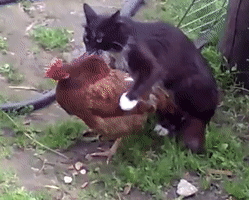 Cats sometimes mate with hens.
Cats sometimes mate with hens.
If cat-chicken hybrids are to be produced, the first requirement is that a cat and a chicken must mate. And in fact, it is well established that male cats will mount chickens and copulate with them (see, for example, the video at right). And such matings may indeed be quite numerous when one considers all the chickens and cats that daily come into contact on farms.
The next question is whether such a mating could possibly produce hybrids. The truth is that no systematic investigation has been made of this cross. It is known, however, that in certain fairly distant crosses many inseminations are required to produce only a few hybrids. For example, artificial insemination of turkey hens with rooster semen yields only about one mature hybrid per thousand inseminations.
Cat-chicken hybrids: Reports
So then, is it possible that matings between cat and chicken also, on rare occasion, produce cat-chicken hybrids? Judging from old news reports, the answer to this question seems to be in the affirmative, because more than one account these animals have been found in a chicken’s brood, and one such animal was actually reported to have emerged from a chicken egg hatched in an commercial incubator.
One notice appeared in the Ebensburg, Pennsylvania, Cambria Freeman (Apr. 30, 1880, p. 2, col. 4):
A report about another cat-chicken hybrid appeared on the front page, column 4, of the June 15, 1906 issue of the Chariton Courier, a newspaper published in Keytesville, Missouri (source). It reads as follows:
A Kansas Freak
And the following report is marked in red because it specifically states that a winged cat came from an egg laid by a chicken. (So here, it seems, we have an answer, also, to the question, Which came first, the winged-cat or the egg?) This report appeared in many newspapers across the U.S., but the following was copied from the Monroe City, Missouri, Democrat (Apr. 25, 1901, p. 5, col. 5):
Winged Cat From Egg
It has two well formed wings, a cat’s head and four legs.
A different chicken with four legs, but this time with a cat’s tail instead of a head, was reported in the Albany, Oregon, Record (Nov. 19, 1875, p. 4, col. 4):
 Albrecht von Haller
Albrecht von Haller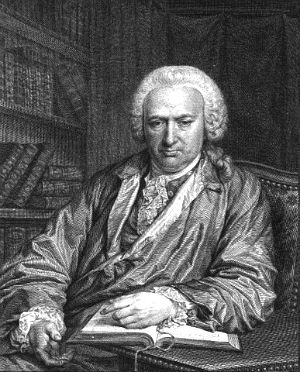 Charles Bonnet
Charles Bonnet
The Yamhill case is paralleled both by the Cheney, Kansas, case already cited, and by a case mentioned in the correspondence of the eighteenth-century naturalists Albrecht von Haller (1708-1777) and Charles Bonnet (1720-1793). In a letter to Haller dated July 18, 1759 (see Sonntag 1983, p. 177) Bonnet says
Subsequently (p. 180), Bonnet refers back to the letter quoted above, "I spoke to you about the singular case of this hen who produced a quadruped. Where, I ask you, did the germ of that chick, there within its egg, obtain that required to develop four legs and a tail?" [Translated by E. McCarthy. Original French: “Je vou parlois de l’accoûchement singulier d’une Poule qui à mis au jour un petit Quadrupéde. Je vous demandois à cette occasion d’ou le Germe du Poulet caché dans l’Œuf avoit pû recevoir quatre Pattes et une longue Queüe?
Another report suggests cat but could certainly be more specific. It appeared in the Baxter Springs, Kansas, News (Jan. 6, 1900, p. 1, col. 4):
Winged cats with four wings
And some cat-like animals, too, have been reported to have four wings. An example, is a brief account that appeared on page 6 (column 4) of the October 26, 1906 issue of The Worthington Advance, a newspaper published in Worthington, Minnesota (source):
A Cat with Wings
What are these animals?
Given the news stories just quoted—specifically those reporting cat-like animals with wings hatched from eggs—it seems that we must either suppose (1) that these widely circulated reports were hoaxes carried out by different individuals, at different times, in different places, or (2) that cat-chicken hybrids do occasionally, perhaps only very rarely, occur.
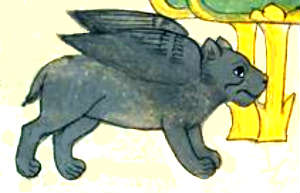
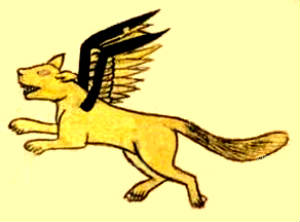 Early representations of winged cats (Zakariya al-Qazwini, Marvels of Things Created and Miraculous Aspects of Things Existing, 13th century).
Early representations of winged cats (Zakariya al-Qazwini, Marvels of Things Created and Miraculous Aspects of Things Existing, 13th century).
Some may find the latter explanation implausible, but it must be remembered that there must be some causative event producing winged cats, for these animals have definitely been observed. If that cause is not hybridization, then what? It seems only reasonable—given that many different people have observed winged cats, and given that various others have reported such animals hatching from chicken eggs—at least to entertain the idea that these animals are hybrids. Better to investigate the possibility than to ignore it. As Abelard once said, “By doubting we come to questioning, and by questioning we perceive the truth.” Moreover, in connection with this cross it should be considered that there is even better empirical evidence available for another, related cross, chicken x human. The curious reader can access that evidence here
A video documenting that hens sometimes adopt kittens.
A second video about a hen adopting kittens.
Imprinting
It’s well established that hens will adopt kittens (see the videos at right). In fact, hens are renowned for their willingness to adopt the young of almost any animal.
The fact that hens will raise kittens is significant in the present context because most mammals imprint on whatever kind of animal raises them, that is, a cat raised by a hen, when it reached sexual maturity, would likely choose a mate with a hen (read a discussion of imprinting elsewhere on this website).
Imprinting may explain, too, why some cats voluntarily choose to live with chickens (see news story towards the bottom of this page entitled Cat’s Strange Whim) and/or incubate chicken eggs (see report below, Chickens Hatched by a Cat).
I have not as yet found an example on YouTube of the reverse case, that of a cat fostering chicks. Such behavior has, however, been repeatedly observed, as documented by news reports (Example 1, Example 2, Example 3, Example 4, Example 5, Example 6). Note that the fourth example mentions that the cat actually nursed the chicks. To read four other, longer news stories about cats adopting chicks, click here and here and here and here.
Cats, at least certain rare cats, voluntarily incubate chicken eggs. The behavior of one such cat is described in the story quoted below, which appeared on page 4, column 4 of the December 11, 1879 issue of The Anderson Intelligencer, a newspaper published in Anderson, South Carolina (source). It originally appeared in the New York Herald. The report reads as follows:
Chickens Hatched by a Cat
A remarkable cat lives at No. 63 Fifteenth street, South Brooklyn. From an early age she has displayed a great fondness for hatching out chickens. She sets on eggs like an old hen until the feathered young break the shell, and then she cares for them as affectionately as if they were orthodox kittens. Four families of chickens have been hatched by this cat, and she is now busily engaged on the fifth, with a very fair prospect of success. The animal is the property of Mrs. Leonard, an intelligent Irish woman, who resides with her husband in a cottage at the above address.
A Herald reporter called at the house yesterday afternoon to see the wonder. In one corner of the kitchen, partitioned off from the rest of the rooms, was a large bird cage, around which a dozen chickens were strutting and picking up a meal. Inside of the cage, on a bed of straw, was a cat of unprepossessing appearance, but of stalwart proportions, covering four eggs. The latter was disclosed to view as the reporter approached the cage, and the animal left her nest to play with a chicken. Then she returned to her task, extending her body at full length over the eggs and completely hiding them. The chickens she had already brought into the world seemed to possess as much filial affection as is generally shown by little chicks for their natural mothers, and they pirouetted about the cat in the most familiar way, climbing on her back, enjoying her warm coat of fur until a movement of her body tumbled them off. After she had become weary of setting, the cat made a tour among her young and carried them to different parts of the enclosure. Her method of transportation was by the neck, and the chickens did not seem to mind this kind of transit any more than if they were kittens. She has been very kind to them, and has never made a meal of her offspring. It is related that when her first chicks appeared she carried one of them by the neck up the cellar stairs. The flesh of the young biped being very tender and the journey somewhat long, blood soon flowed. Instead of devouring the chick after she had tasted its blood, she applied her tongue daily to the neck until the wound healed.
The cat came to Mrs. Leonard’s house about a year ago unheralded and unknown, and next day was found on a nest of eggs deserted by a hen who should have been setting. Sue was driven off repeatedly, for fear she would break the eggs; but, persisting in her purpose, brought forth a brood of chickens that astonished the household. About a score of chickens have been brought into the world through her agency, eight of which survive. South Brooklyn has been very much interested over the phenomenon, and hundreds of visitors have seen and admired the feline incubator. -New York Herald.
Winged Cats: Reports
Many different reports about winged cats exist, far more than can be conveniently quoted on this webpage. One such report, which circulated widely, describes a mature cat with “pheasant’s wings.” The story quoted here appeared in the June 26, 1897 issue of the High Peak News, a newspaper published in Matlock, Derbyshire, England. A chicken is a type of pheasant, but in England any reference to a “pheasant” would almost certainly refer to the common pheasant (Phasianus colchicus), not a chicken. The report reads as follows:
Extraordinary Capture at Winster
A Tomcat With Wings
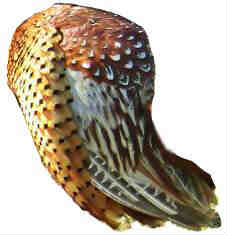 A pheasant’s wing
A pheasant’s wing(Phasianus colchicus)
The most interesting item in natural history, so far as the Matlock district is concerned, transpired this morning (Friday). Our reporter learns that Mr Roper of Winster, while on Brown Edge near that village, shot what he thought to be a fox, which had been seen in the locality some time previously, on Mr Foxlow’s land. Thinking he had missed his aim, Mr Roper gave up the quest, but returning later he found he had killed the animal. It proved to be an extraordinarily large tomcat, tortoiseshell in colour with fur two and a half inches long, with the remarkable addition of fully-grown pheasant wings projecting from each side of its fourth rib. Unfortunately, the climate having been so excessively hot, the animal was allowed to putrefy, and after being generally exhibited all round the district the carcase has now been interred. It was seen by Mr Joseph Hardy and ample witnesses, so that there is no doubt the museums have missed a most curious animal. Never has its like been seen before, and eye-witnesses state that when running the animal used its wings outstretched to help it over the surface of the ground, which it covered at a tremendous pace.
In 1926 a cat with wings was found in a chicken yard in Wapato, Washington. Its owner took it on tour and charged thousands to see it. The following story about this animal appeared that year in Time magazine (Monday, Dec. 27, 1926, p. 54). This cat, however, had four wings, not two.
Science: Winged Cat
Citizens of Portland, Ore., flocked to see a curious creature publicly exhibited by one Arthur Kingery of Wapato, Wash., who said he had captured it in his chicken-yard. It was a cat, thrice the size of a house cat [note that the Matlock animal, described above, was supposed to be “extraordinarily large.” Luxuriant growth, a manifestation of heterosis, is common in hybrids.], with a tail heavy and furry, like a coyote’s. On each side of its spine, beginning just back of the shoulders, grew a pair of muscular ridges, for all the world like two pairs of rudimentary wings, furred heavily. The feline’s hind feet measured five inches, spreading out like the feet of a snow-shoe rabbit.
Old settlers were reminded of Paul Bunyan’s “minktums” and “tigermonks.” Natural scientists suspected it was a cross between a lynx and a house cat. Nature lovers recalled that Naturalist Henry David Thoreau, in his book Walden mentioned a “winged cat.” It was the pet of a farmer-neighbor, described as “dark brownish grey color, with a white spot on her throat, and white feet, and had a large bushy tail like a fox; that in the winter the fur grew thick and flatted out along her sides, forming strips ten or twelve inches long by two and a half wide, and under her chin like a muff, the upper side loose, the under matted like felt, and in the spring these appendages dropped off. They gave me a pair of her ‘wings,’ which I keep still. There is no appearance of a membrane about them.” [See the complete passage from Thoreau, quoted below.]
The following report, and various others like it, about a Spanish winged cat named Angolina circulated widely. This a transcript of the report as it appeared on page 6 of the Medford Mail Tribune, a newspaper published in Medford, Oregon:
Fur-Winged Cat Amazes Spain
Birds Too If It Learns To Fly
Madrid, Spain, May 31 (U.P) — It will be a sad day for the birds when Angolina learns to use her wings. Angolina is a cat. And she is the only cat in this or any other country with wings, her owner, Juan Priego, proudly claims. Priego’s cat, a dusty gray angora, has 10-inch fur-covered wings sprouting from the middle of her back and folding neatly over each side.
Priego admitted that Angolina still has not learned how to spread her wings and take off after birds in their own element, but he explained that she is pretty young yet. “We have had her three months,” the 55 year-old Priego said. “We took her over from a neighbor who would not feed her. Except for the wings, she is like any other cat.” And Angolina is. She has green eyes, whiskers and she meows.
Priego and his 50-year-old wife, Victoria, have given Angolina a place of honor in the kitchen of their basement apartment because such is such an unusual pet. So unusual, In fact, that Priego has turned down offers running as high as $70,000 and plans to take her on tour in Mexico next week if the government will give him and his cat a passport.
Fee charged
He said 30,000 persons have tried to get a look at Angolina since the news got out that she is a cat with wings. “We started out charging a fee to see her, but it got out of bounds,” Priego said. He said the rush was so great it nearly drove his wife crazy. Mrs. Priego, armed with a stick to repulse a horde of curious visitors trying to peek in through the kitchen door, confirmed this. “I have been married 30 years, but I never went through anything like this,” she said. “I can’t rest, eat or sleep anymore. It’s horrible.”
Priego said his cat has many admirers. “An air force captain offered to swap me his house for her. Wanted to take her on tour.” He wouldn’t say who the air force captain was, but said another bidder had offered him 700,000 pesetas ($70,000) if he would sell Angolina. Doctors who have examined Angolina say that the wings are real. They are formed by a type of cartilage. All the excitement doesn’t bother Angolina. Wings folded neatly over her body, she dozes in the Priego kitchen and licks her wings — almost like any other cat.
The following is another news report, a United Press wire story dated June 14th, 1950, about the animal shown in the picture above:
Second Winged Cat Crops Up in Spain
by Haynes Thompson
Madrid, Spain. Mithi is just like any other cat with wings, except than Mithi can fly. Or so claims Mithi’s owner, Senora Josefa Munoz, 63 year-old widow. The claim is doubted by the owner of Angolina [see below], a cat which has wings but doesn’t fly.
Senora Munoz , permitted this correspondent to stroke Mithi’s foot-long Angora wingspread. There was a purr like an airplane, motor. But she wouldn’t ask the cat to fly. You just have to take the word of Senora Munoz, who has an honest-looking face, or the word of her neighbors. Mithi just took to the ozone last week, Senora Munoz said. Mithi was perched on a six-foot back fence when suddenly she meowed and went into a 15-foot glide, landing on the roof of an inside court, her owner said. The widow Munoz insisted “It was more than a jump. Mithi’s wings were out and she seemed to glide."
“They eat cat food, not bird seed.”
Senora Munoz said Mithi has been flying each day since her solo and the neighbors, whose kitchen windows overlook the roofed court, agreed. By yesterday several thousand curious were standing outside the Munoz home. “We can’t go on like this,” Senora Munoz fretted as she looked at the crowd pressed around her door, “We’ll have to sell Mithi.” She said she already has received an offer of $4000.
But Juan Priego, owner of Angolina, Spain’s first winged cat to receive publicity, poo-poohed the story of Mithi. Angolina is on display in a glass cage at an exhibit where persons paid two pesetas each to see her yesterday. The two winged cats this correspondent has seen, Mithi, and Angolina are in other respects alike. They eat cat food, not bird seed.
|
Thoreau’s Winged Cat In Walden, Henry David Thoreau gave the following account: “A few years before I lived in the woods there was what was called a ‘winged cat’ in one of the farm-houses in Lincoln nearest the pond, Mr. Gilian Baker’s. When I called to see her in June 1842 she was gone a-hunting in the woods, as was her wont (I am not sure whether it was a male or a female and so use the more common pronoun), but her mistress told me that she came into the neighbourhood a little more than a year before, in April, and was finally taken into their house; that she was of a dark brownish-grey colour, with a white spot on her throat, and white feet, and had a large bushy tail like a fox; that in the winter the fur grew thick and flatted out along her sides, forming strips ten or twelve inches long by two and a half wide, and under her chin like a muff, the upper side loose, the under matted like felt, and in the spring these appendages dropped off. They gave me a pair of her ‘wings,’ which I keep still. There is no appearance of a membrane about them. Some thought it was part flying squirrel or some other wild animal, which is not impossible, for, according to naturalists, prolific hybrids have been produced by the union of the marten and domestic cat. This would have been the right kind of cat for me to keep if I had kept any; for why should not a poet’s cat be winged as well as his horse?” |
Chickens with four legs
Some reports do not mention cats at all, but do refer to chickens with four legs. Such birds may represent simple conjoined twins without hybrid parentage. The fact that conjoined twins with four legs occur at low rates among chickens and other birds has long been recognized, as evidenced by the figure at right taken from a 16th century tract on marvels (Lycosthenes 1557, p. 618). It shows a chicken found in France in 1551 (a modern example, a similar turkey). On the other hand, it’s possible that such reports sometimes refer to composite cat-chicken hybrids. An example of such an ambiguous report is the notice quoted below, which appeared in the Ottawa, Illinois, Free Trader-Journal (Jul. 30, 1918, p. 2, col. 5):
Has Four-Legged Rooster
Another such report appeared in the Bemidji, Minnesota, Daily Pioneer (Aug. 16, 1922, p. 5, col. 4):
Mother Hen Proud of Freak
Chickens with four legs and four wings
Some reports describe animals that have not only four legs, but also four wings. Once such, a chick hatched in Brooklyn, New York, was pictured in many newspapers around the country in 1897 (see image at right). Note that this chick had its legs arranged in the same way as an ordinary quadruped, and was reported to walk like an ordinary quadruped (a viable turkey with the same body structure was reported in 1912, another four-winged turkey). But the bird pictured by Lycosthenes above had two separate bodies, each with two legs, connected by a common head, an arrangement that would presumably hamper ordinary locomotion. In many of the brief news reports, it is unclear which of these two bodily configurations was in question. There are many such ambiguous reports on record (Example 1, Example 2, Example 3, Example 4, Example 5, Example 6), Example 7). One such chick was arranged in a push-me-pull-you configuration with one set of wings and legs facing forward and the other, backwards (access report). Another had four legs and four wings, but only one eye (access report). A duck hatched from a double-yolked egg had four legs and four wings with one pair of legs pointing up, the other down, so that it could easily turn over and walk upside-down (access report, a separate duck case).
Winged cats with four wings
And some cat-like animals, too, have been reported to have four wings. An example, is a brief account that appeared in the Worthington, Minnesota, Advance (Oct. 26, 1906, p. 6, col. 4):
A Cat with Wings
What are these animals?
Given the news stories just quoted—specifically those reporting cat-like animals with wings hatched from eggs—it seems that we must either suppose that these widely circulated reports were either (1) hoaxes carried out by different individuals, at different times, in different places, or (2) that cat-chicken hybrids do occasionally, perhaps only very rarely, occur.

 Early representations of winged cats (Zakariya al-Qazwini, Marvels of Things Created and Miraculous Aspects of Things Existing, 13th century).
Early representations of winged cats (Zakariya al-Qazwini, Marvels of Things Created and Miraculous Aspects of Things Existing, 13th century).
Some may find the latter explanation implausible, but it must be remembered that there must be some causative event producing winged cats, which have definitely been observed. If that cause is not hybridization, then what? It seems only reasonable—given that many different people have observed winged cats, and given that various others have reported such animals hatching from chicken eggs—at least to entertain the idea that these animals are hybrids. Better to investigate the possibility than to ignore it. As Abelard once said, “By doubting we come to questioning, and by questioning we perceive the truth.” Moreover, in connection with this cross it should be considered that there is even better empirical evidence available for another, related cross, chicken x human. The curious reader can access that evidence here
A video documenting that hens sometimes adopt kittens.
A second video about a hen adopting kittens.
Imprinting
It’s well established that hens will adopt kittens (see the videos at right). In fact, hens are renowned for their willingness to adopt the young of almost any animal.
The fact that hens will raise kittens is significant in the present context because most mammals imprint on whatever kind of animal raises them, that is, a cat raised by a hen, when it reached sexual maturity, would likely choose a mate with a hen (read a discussion of imprinting elsewhere on this website).
Imprinting may explain, too, why some cats voluntarily choose to live with chickens (see news story towards the bottom of this page entitled Cat’s Strange Whim) and/or incubate chicken eggs (see report below, Chickens Hatched by a Cat).
I have not as yet found an example on YouTube of the reverse case, that of a cat fostering chicks. Such behavior has, however, been repeatedly observed, as documented by news reports (Example 1, Example 2, Example 3, Example 4, Example 5, Example 6). Note that the fourth example mentions that the cat actually nursed the chicks. To read four other, longer news stories about cats adopting chicks, click here and here and here and here.
Cats, at least certain rare cats, voluntarily incubate chicken eggs. The behavior of one such cat is described in the story quoted below, which appeared on page 4, column 4 of the December 11, 1879 issue of The Anderson Intelligencer, a newspaper published in Anderson, South Carolina (source). It originally appeared in the New York Herald. The report reads as follows:
Chickens Hatched by a Cat
A remarkable cat lives at No. 63 Fifteenth street, South Brooklyn. From an early age she has displayed a great fondness for hatching out chickens. She sets on eggs like an old hen until the feathered young break the shell, and then she cares for them as affectionately as if they were orthodox kittens. Four families of chickens have been hatched by this cat, and she is now busily engaged on the fifth, with a very fair prospect of success. The animal is the property of Mrs. Leonard, an intelligent Irish woman, who resides with her husband in a cottage at the above address.
A Herald reporter called at the house yesterday afternoon to see the wonder. In one corner of the kitchen, partitioned off from the rest of the rooms, was a large bird cage, around which a dozen chickens were strutting and picking up a meal. Inside of the cage, on a bed of straw, was a cat of unprepossessing appearance, but of stalwart proportions, covering four eggs. The latter was disclosed to view as the reporter approached the cage, and the animal left her nest to play with a chicken. Then she returned to her task, extending her body at full length over the eggs and completely hiding them. The chickens she had already brought into the world seemed to possess as much filial affection as is generally shown by little chicks for their natural mothers, and they pirouetted about the cat in the most familiar way, climbing on her back, enjoying her warm coat of fur until a movement of her body tumbled them off. After she had become weary of setting, the cat made a tour among her young and carried them to different parts of the enclosure. Her method of transportation was by the neck, and the chickens did not seem to mind this kind of transit any more than if they were kittens. She has been very kind to them, and has never made a meal of her offspring. It is related that when her first chicks appeared she carried one of them by the neck up the cellar stairs. The flesh of the young biped being very tender and the journey somewhat long, blood soon flowed. Instead of devouring the chick after she had tasted its blood, she applied her tongue daily to the neck until the wound healed.
The cat came to Mrs. Leonard’s house about a year ago unheralded and unknown, and next day was found on a nest of eggs deserted by a hen who should have been setting. Sue was driven off repeatedly, for fear she would break the eggs; but, persisting in her purpose, brought forth a brood of chickens that astonished the household. About a score of chickens have been brought into the world through her agency, eight of which survive. South Brooklyn has been very much interested over the phenomenon, and hundreds of visitors have seen and admired the feline incubator. -New York Herald.
Winged Cats: Reports
Many different reports about winged cats exist, far more than can be conveniently quoted on this webpage. One such report, which circulated widely, describes a mature cat with “pheasant’s wings.” The story quoted here appeared in the June 26, 1897 issue of the High Peak News, a newspaper published in Matlock, Derbyshire, England. A chicken is a type of pheasant, but in England any reference to a “pheasant” would almost certainly refer to the common pheasant (Phasianus colchicus), not a chicken. The report reads as follows:
Extraordinary Capture at Winster
A Tomcat With Wings
 A pheasant’s wing
A pheasant’s wing(Phasianus colchicus)
The most interesting item in natural history, so far as the Matlock district is concerned, transpired this morning (Friday). Our reporter learns that Mr Roper of Winster, while on Brown Edge near that village, shot what he thought to be a fox, which had been seen in the locality some time previously, on Mr Foxlow’s land. Thinking he had missed his aim, Mr Roper gave up the quest, but returning later he found he had killed the animal. It proved to be an extraordinarily large tomcat, tortoiseshell in colour with fur two and a half inches long, with the remarkable addition of fully-grown pheasant wings projecting from each side of its fourth rib. Unfortunately, the climate having been so excessively hot, the animal was allowed to putrefy, and after being generally exhibited all round the district the carcase has now been interred. It was seen by Mr Joseph Hardy and ample witnesses, so that there is no doubt the museums have missed a most curious animal. Never has its like been seen before, and eye-witnesses state that when running the animal used its wings outstretched to help it over the surface of the ground, which it covered at a tremendous pace.
In 1926 a cat with wings was found in a chicken yard in Wapato, Washington. Its owner took it on tour and charged thousands to see it. The following story about this animal appeared that year in Time magazine (Monday, Dec. 27, 1926, p. 54). This cat, however, had four wings, not two.
Science: Winged Cat
Citizens of Portland, Ore., flocked to see a curious creature publicly exhibited by one Arthur Kingery of Wapato, Wash., who said he had captured it in his chicken-yard. It was a cat, thrice the size of a house cat [note that the Matlock animal, described above, was supposed to be “extraordinarily large.” Luxuriant growth, a manifestation of heterosis, is common in hybrids.], with a tail heavy and furry, like a coyote’s. On each side of its spine, beginning just back of the shoulders, grew a pair of muscular ridges, for all the world like two pairs of rudimentary wings, furred heavily. The feline’s hind feet measured five inches, spreading out like the feet of a snow-shoe rabbit.
Old settlers were reminded of Paul Bunyan’s “minktums” and “tigermonks.” Natural scientists suspected it was a cross between a lynx and a house cat. Nature lovers recalled that Naturalist Henry David Thoreau, in his book Walden mentioned a “winged cat.” It was the pet of a farmer-neighbor, described as “dark brownish grey color, with a white spot on her throat, and white feet, and had a large bushy tail like a fox; that in the winter the fur grew thick and flatted out along her sides, forming strips ten or twelve inches long by two and a half wide, and under her chin like a muff, the upper side loose, the under matted like felt, and in the spring these appendages dropped off. They gave me a pair of her ‘wings,’ which I keep still. There is no appearance of a membrane about them.” [See the complete passage from Thoreau, quoted below.]
The following report, and various others like it, about a Spanish winged cat named Angolina circulated widely. This a transcript of the report as it appeared in on page 6 of the Medford Mail Tribune, a newspaper published in Medford, Oregon:
Fur-Winged Cat Amazes Spain
Birds Too If It Learns To Fly
Madrid, Spain, May 31 (U.P) — It will be a sad day for the birds when Angolina learns to use her wings. Angolina is a cat. And she is the only cat in this or any other country with wings, her owner, Juan Priego, proudly claims. Priego’s cat, a dusty gray angora, has 10-inch fur-covered wings sprouting from the middle of her back and folding neatly over each side.
Priego admitted that Angolina still has not learned how to spread her wings and take off after birds in their own element, but he explained that she is pretty young yet. “We have had her three months,” the 55 year-old Priego said. “We took her over from a neighbor who would not feed her. Except for the wings, she is like any other cat.” And Angolina is. She has green eyes, whiskers and she meows.
Priego and his 50-year-old wife, Victoria, have given Angolina a place of honor in the kitchen of their basement apartment because such is such an unusual pet. So unusual, In fact, that Priego has turned down offers running as high as $70,000 and plans to take her on tour in Mexico next week if the government will give him and his cat a passport.
Fee charged
He said 30,000 persons have tried to get a look at Angolina since the news got out that she is a cat with wings. “We started out charging a fee to see her, but it got out of bounds,” Priego said. He said the rush was so great it nearly drove his wife crazy. Mrs. Priego, armed with a stick to repulse a horde of curious visitors trying to peek in through the kitchen door, confirmed this. “I have been married 30 years, but I never went through anything like this,” she said. “I can’t rest, eat or sleep anymore. It’s horrible.”
Priego said his cat has many admirers. “An air force captain offered to swap me his house for her. Wanted to take her on tour.” He wouldn’t say who the air force captain was, but said another bidder had offered him 700,000 pesetas ($70,000) if he would sell Angolina. Doctors who have examined Angolina say that the wings are real. They are formed by a type of cartilage. All the excitement doesn’t bother Angolina. Wings folded neatly over her body, she dozes in the Priego kitchen and licks her wings — almost like any other cat.
The following is another news report, a United Press wire story dated June 14th, 1950, about the animal shown in the picture above:
Second Winged Cat Crops Up in Spain
by Haynes Thompson
Madrid, Spain. Mithi is just like any other cat with wings, except than Mithi can fly. Or so claims Mithi’s owner, Senora Josefa Munoz, 63 year-old widow. The claim is doubted by the owner of Angolina [see below], a cat which has wings but doesn’t fly.
Senora Munoz , permitted this correspondent to stroke Mithi’s foot-long Angora wingspread. There was a purr like an airplane, motor. But she wouldn’t ask the cat to fly. You just have to take the word of Senora Munoz, who has an honest-looking face, or the word of her neighbors. Mithi just took to the ozone last week, Senora Munoz said. Mithi was perched on a six-foot back fence when suddenly she meowed and went into a 15-foot glide, landing on the roof of an inside court, her owner said. The widow Munoz insisted “It was more than a jump. Mithi’s wings were out and she seemed to glide."
“They eat cat food, not bird seed.”
Senora Munoz said Mithi has been flying each day since her solo and the neighbors, whose kitchen windows overlook the roofed court, agreed. By yesterday several thousand curious were standing outside the Munoz home. “We can’t go on like this,” Senora Munoz fretted as she looked at the crowd pressed around her door, “We’ll have to sell Mithi.” She said she already has received an offer of $4000.
But Juan Priego, owner of Angolina, Spain’s first winged cat to receive publicity, poo-poohed the story of Mithi. Angolina is on display in a glass cage at an exhibit where persons paid two pesetas each to see her yesterday. The two winged cats this correspondent has seen, Mithi, and Angolina are in other respects alike. They eat cat food, not bird seed.
|
Thoreau’s Winged Cat In Walden, Henry David Thoreau gave the following account: “A few years before I lived in the woods there was what was called a ‘winged cat’ in one of the farm-houses in Lincoln nearest the pond, Mr. Gilian Baker’s. When I called to see her in June 1842 she was gone a-hunting in the woods, as was her wont (I am not sure whether it was a male or a female and so use the more common pronoun), but her mistress told me that she came into the neighbourhood a little more than a year before, in April, and was finally taken into their house; that she was of a dark brownish-grey colour, with a white spot on her throat, and white feet, and had a large bushy tail like a fox; that in the winter the fur grew thick and flatted out along her sides, forming strips ten or twelve inches long by two and a half wide, and under her chin like a muff, the upper side loose, the under matted like felt, and in the spring these appendages dropped off. They gave me a pair of her ‘wings,’ which I keep still. There is no appearance of a membrane about them. Some thought it was part flying squirrel or some other wild animal, which is not impossible, for, according to naturalists, prolific hybrids have been produced by the union of the marten and domestic cat. This would have been the right kind of cat for me to keep if I had kept any; for why should not a poet’s cat be winged as well as his horse?” |
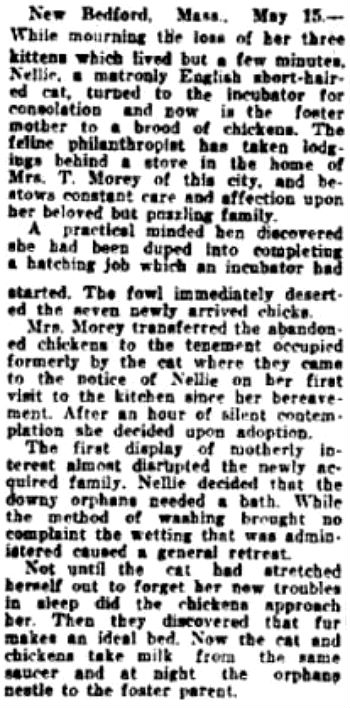 Above: Screenshot of a news story about a cat who adopted baby chicks that appeared on page 2 (columns 3 and 4) of the May 16, 1921 issue of the Great Falls Tribune, a newspaper published in Great Falls, Montana (source).
Above: Screenshot of a news story about a cat who adopted baby chicks that appeared on page 2 (columns 3 and 4) of the May 16, 1921 issue of the Great Falls Tribune, a newspaper published in Great Falls, Montana (source).
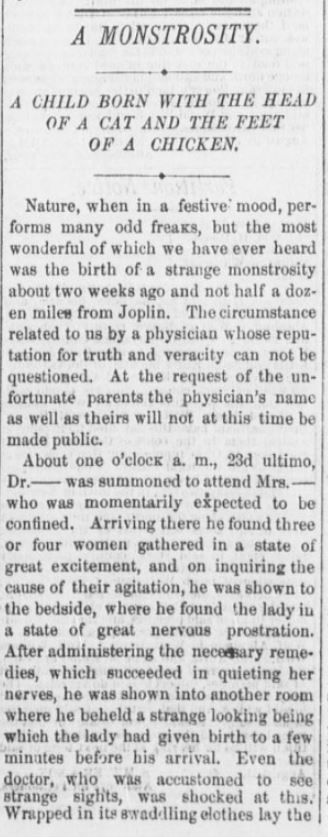
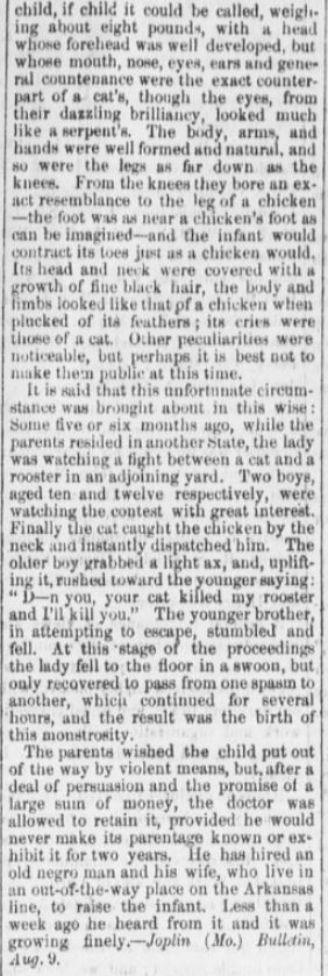 Above: A news story about a woman birthing a creature that combined characteristics of a cat, a chicken and a human. It appeared in columns 3 and 4, page 3, of the August 26, 1875, issue of The Stark County Democrat, a newspaper published in Canton, Ohio (source). One hypothesis that might account for this birth is that a partially fertile cat-chicken hybrid somehow managed to fertilize the human mother. Another, of course, is that the report is simply a hoax. In connection with this subject, it may be noted that there are various reports about a women giving birth to a cat-human hybrids. Numerous human-chicken hybrids have also been reported.
Above: A news story about a woman birthing a creature that combined characteristics of a cat, a chicken and a human. It appeared in columns 3 and 4, page 3, of the August 26, 1875, issue of The Stark County Democrat, a newspaper published in Canton, Ohio (source). One hypothesis that might account for this birth is that a partially fertile cat-chicken hybrid somehow managed to fertilize the human mother. Another, of course, is that the report is simply a hoax. In connection with this subject, it may be noted that there are various reports about a women giving birth to a cat-human hybrids. Numerous human-chicken hybrids have also been reported.
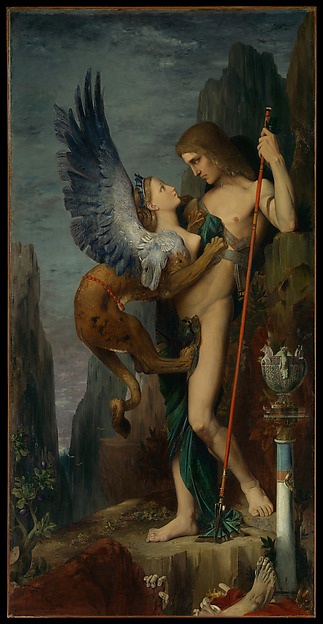 Above: Oedipus and the Sphinx by Gustave Moreau, a depiction of a cat-bird-human hybrid.
Above: Oedipus and the Sphinx by Gustave Moreau, a depiction of a cat-bird-human hybrid.
By the same author: Handbook of Avian Hybrids of the World, Oxford University Press (2006).
Most shared on Macroevolution.net:
Human Origins: Are we hybrids?
On the Origins of New Forms of Life
Mammalian Hybrids
Cat-rabbit Hybrids: Fact or fiction?
Famous Biologists
Dog-cow Hybrids
Georges Cuvier: A Biography
Prothero: A Rebuttal
Branches of Biology
Dog-fox Hybrids